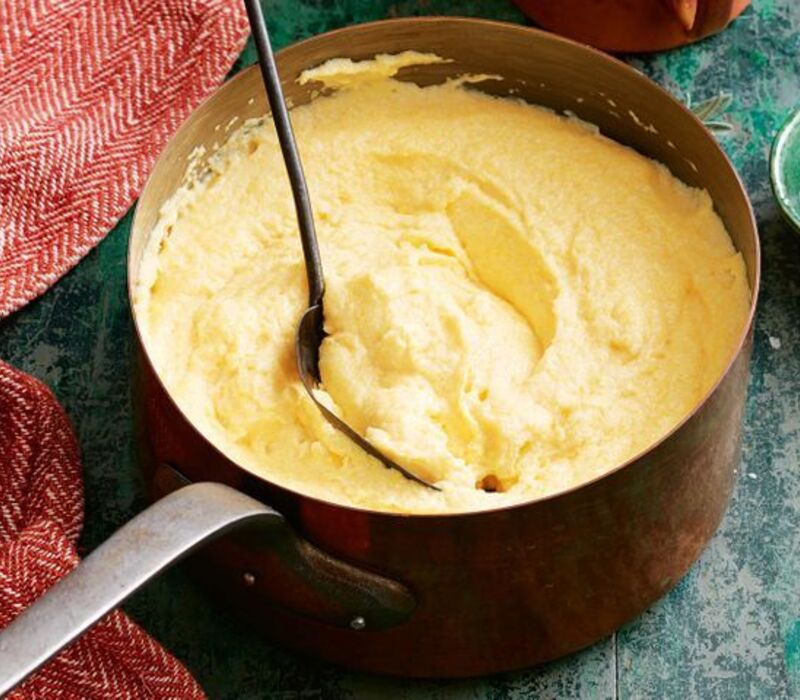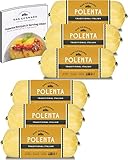Well, this is your lucky day! I find out that is polenta gluten free, dairy-free, and vegan. I discover the many ways you can enjoy polenta and where to buy it. If you enjoy polenta, you may be wondering if this dish is safe for your gluten-free diet.
Or if you’re just getting with a gluten-free diet, you may be curious to find some new side dishes or grain ideas that don’t contain gluten.
Whatever brought you here, we know that anything we eat on a gluten-free diet needs to be looked at with a thoughtful eye before enjoying. This is also true for any grain dishes, like polenta.
That’s why in this post I am digging in to understand what polenta is, and help answer all the questions you might have about polenta. I’ll also talk about how polenta can fit into your gluten-free diet, and how to make it at home.
Page Contents
Do You Know What is Polenta?
Polenta is a dish of boiled cornmeal. It can be made into a creamy side dish or a breakfast porridge. Polenta can also be cooked, then cooled, and cut into slices to fry for crispy polenta.
This dish originates from Italy and has become a new popular side dish in the United States, especially among the gluten-free crowd. I have also written an article on Enjoy to Make Shrimp and Polenta Recipe.
What is Gluten?

Gluten is a protein found in most wheat products and acts as the “glue” that helps to hold wheat, barley, Kamut, spelled, farro, durum, bulgur, rye, and semolina together to maintain their shape.
You can find gluten in whole grains, but also in many processed foods as well. If you purchase wheat bread, there will be gluten in it, because wheat by nature has gluten.
Many grains have gluten even if they are grains that don’t contain gluten themselves due to cross-contamination. This is something to be mindful of when you’re following a gluten-free diet.
Is Polenta Gluten Free?
Polenta is from cornmeal, making this a naturally gluten-free food. As mentioned before, look for a package with a gluten-free label to ensure that cross-contamination with other gluten-containing grains is avoided.
Additionally, gluten is commonly used in baked goods to bind the ingredients of a recipe together, allowing the dish to maintain its shape. You can also read more about Polenta Calories: A Comprehensive Guide.
How do You Eat Polenta Gluten Free?
Polenta can be enjoyed in several ways. Here are just a few ideas I’ve tried or have come across in my research:
- Served plain or with herbs as a side dish
- In place of rice or pasta in a bowl with vegetables or meat sauce (this is my favorite!)
- As a breakfast porridge, with cinnamon, nuts, and fruit
- Grilled polenta rounds as a side dish or the base for an appetizer
- As a base for stews or chili to round out the meal
- Polenta is a great budget-friendly ingredient as it’s inexpensive and easy to find
Where to Buy Polenta?
You can buy polenta at most grocery stores. I usually find it in the health food section of my grocery store along with other gluten-free grains.
I try to pick up the Bob’s Red Mill brand because they are always clear with their gluten-free labeling and I know this company has dedicated gluten-free processing lines.
There are other brands available as well, like Ancient Harvest, Molino, Colavita, Roland, and San Gennaro. You can also get more from this video.
How to Store Polenta Gluten Free?
Polenta can be stored in a sealed container for up to two years in a cool dark place, like a pantry or cabinet.
I prefer to keep my polenta and other grains in glass airtight jars in my pantry. Another on Frying Polenta: Tips and Tricks for a Mouthwatering Meal.
Fixings
4 cups of your choice of liquid
1 cup coarse cornmeal (polenta)
1 tbsp butter, vegan butter, or olive oil (optional)
½ tsp salt (optional)
How to Make?
In a large pot over high heat, bring the liquid to a boil. You can use any type of liquid you wish: water, chicken or vegetable stock or broth, milk, or dairy-free milk.
Slowly stir the cornmeal into the boiling liquid until there are no lumps.
Lower the heat and whisk continuously, about 5 minutes, until the polenta thickens. You don’t want to walk away here or the bubbles that form in the polenta as it cooks will start to explode in your kitchen – trust me, you don’t want hot exploding polenta all over your kitchen or you!
Optionally, add butter, vegan butter, or olive oil and salt for flavor and creaminess to finish the dish off.
Add toppings for a breakfast porridge, fresh herbs for a side dish, or keep it plain. Serve up into bowls or plates and enjoy the underrated deliciousness of polenta.
Varieties of Polenta Gluten Free

Like oatmeal, polenta can be found in several varieties. The variety of polenta used is determined by what it’s added to and how it’s presented from coarsely ground to finely ground. Here are a few of the most common types of polenta available in stores.
- Coarse ground polenta
- Yellow Corn Polenta
- Finely ground polenta
- Instant polenta
- White polenta
- Precooked (tube) polenta
What Does Polenta Gluten Free Taste Like?
Made solely from corn, it’s no surprise that polenta embodies corn’s sweetness. When cooked correctly, polenta will taste smooth and sweet, not bitter and raw.
While polenta’s taste may vary depending on the cooking method used, the better the quality of the cornmeal you start with, the better your dish will taste.
Conclusion
Now that you know more about polenta and its gluten-free properties, it’s time to start cooking with it. Ideal for gluten-free and grain-free cooking, polenta can be used to create sweet and savory recipes that eaters of all ages will enjoy. I wish you a healthy and happy day!
Do you enjoy cooking with polenta regularly? I love to hear more about the delicious recipe you create with this superfood ingredient. Share your favorite polenta-based meals with us in the comments below.
People with coeliac disease can safely eat many common plants, seeds, grains, cereals, and flour, including corn, polenta, potatoes, rice, and soya.
As it’s made from corn, polenta is naturally gluten-free. Additionally, it has an amazing taste and often features in savory dishes – but it is spectacular in sweet stuff as well, such as in this mouthwatering gluten & dairy-free orange polenta cake.
They’re responsible for some of its sour, bitter, and astringent flavors. These compounds are thought to reduce the risk of age-related diseases through their antioxidant properties.






